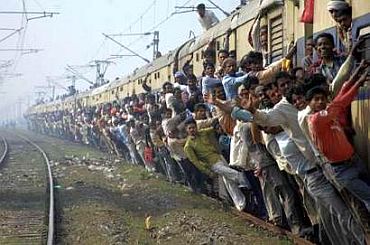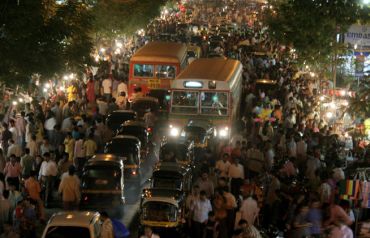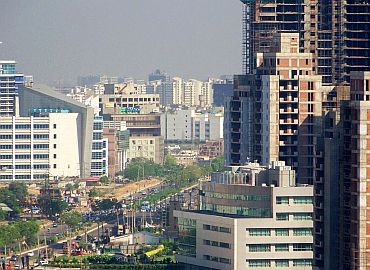Photographs: Reuters
India's burgeoning population has seen a five-fold increase over the last 100 years and will surpass that of China by 2050.
Projections made by the government show that while India's population grew by 1.4 per cent over the last five years, China saw only a 0.6 per cent population growth for the corresponding period.
India's total population in 2009 was 119.8 crore, China's 134.5 crore and Pakistan's 18 crore. While India's population will increase to 161.38 crore by 2050, that of China will only reach 141.7 crore.
Interestingly, Pakistan's population grew at the highest rate in the sub-continent -- 2.2 per cent over the last five years.
Another 371 million people by 2026
India will have to share an additional burden of 371 million by 2026.
Out of this, Uttar Pradesh will have a share of 22 per cent of the population, Bihar eight per cent, Uttarakhand one per cent, the four southern states 13 per cent and Madhya Pradesh and Rajasthan 7 per cent each.
The report by the 'Janasankhya Sthirta Kosh' under the Ministry of Health and Family Welfare said if India continues at the current pace it will double its population in the next 50 years making sustainable development unattainable.
Another interesting fact is that the individual populations of Indian states equal the total population of many countries.
Bihar has more people than Germany
For example, Uttar Pradesh with a population 18.3 crore nearly touches that of Brazil at 18.7 crore, Maharashtra's 10.4 crore is equal to that of Mexico's 10.4 crore and Bihar's nine crore is more than Germany's 8.3 crore.
Talking about aspects of family planning, which have been initiated over the years, the report says the rate of sterilisation was the highest in Chhattisgarh at 74 per cent while in Jharkhand 68 per cent had been achieved.
Rajasthan had 73 per cent sterilisation, Uttar Pradesh 43 per cent and Madhya Pradesh 58 per cent.
Blame it on high infant mortality rate
According to the document, the major factors fuelling population growth were the high infant mortality rate, which leads to demand for more children, women being married off before the age of 18 and teenage pregnancies.
Urban areas in the country are on the verge of bursting at the seams with official data indicating rapid population explosion, which could touch 53 crore in 2021 as against 32 crore approximately in the ongoing census.
In the ongoing census, the urban population is likely to cross 32 crore when the tabulations are made next year from 28.61 crore in 2001 and given the pace and intensity of urbanisation in the country, the figure could go up to 53 crore in the 10 ten years by the year 2021, officials in the Ministry of Urban Development said.
Severe pressure on civic structure
The percentile growth of population in rural and urban areas during the decade (2001-2011) is 17.9 and 31.2 per cent respectively, they said.
"The trends of urbanisation is encouraging. India would gradually reach the global average in the next decade. The pace has become very rapid now," a senior official said.
The growth of urban population has put severe pressure on civic structure such as water supply, sewerage, drainage, public transport as also availability of housing in all major cities, the officials said.
The 11th Five Year Plan has estimated Rs 53,666 crore for water supply, Rs 53,168 crore for sewage and treatment, Rs 20,173 crore for drainage and Rs 2,212 crore for solid waste management in urban areas.






article